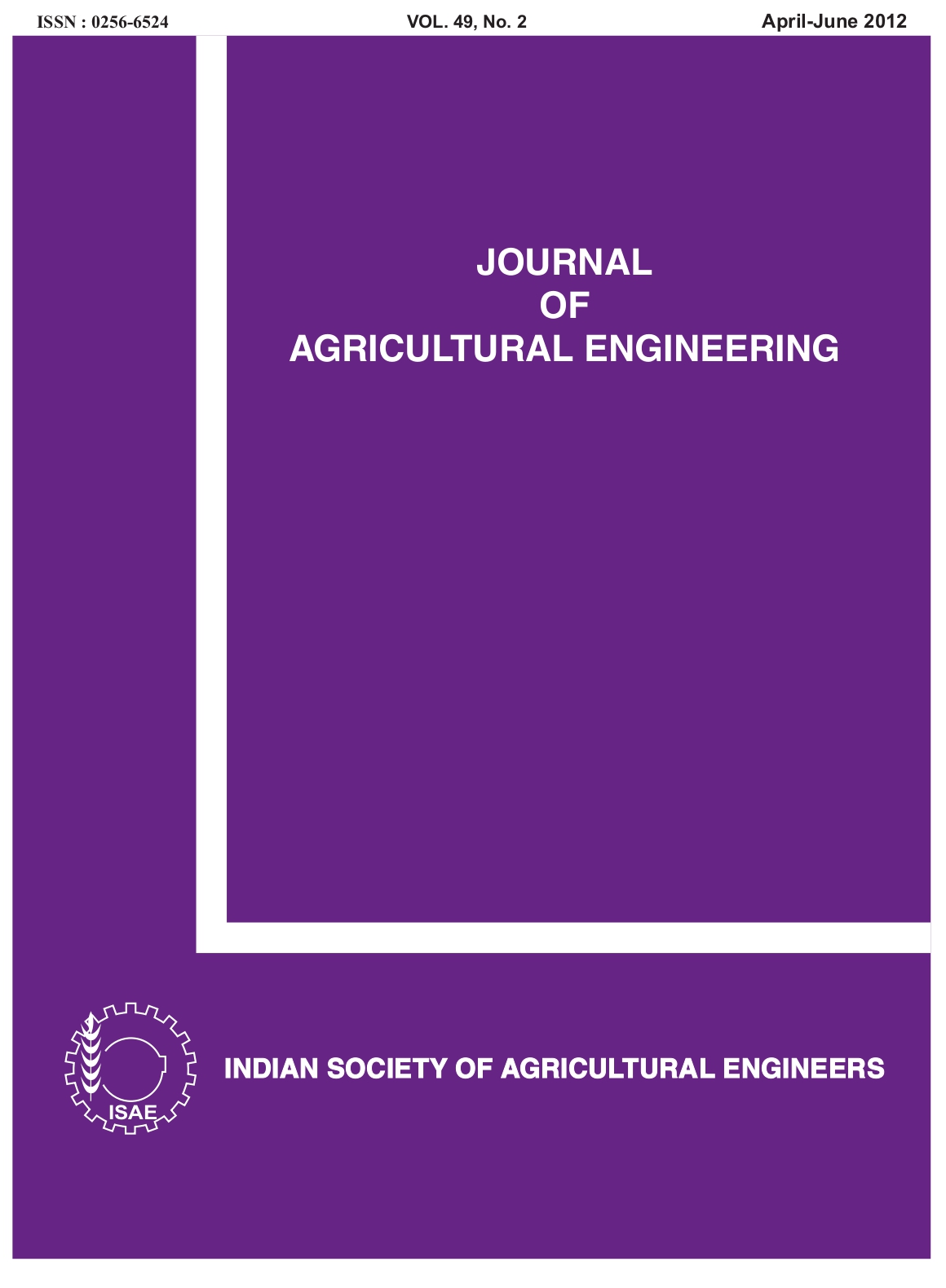Mathematical Model for Shelf-life of Chickpea Sprouts under Modified Atmospheric Packaging
DOI:
https://doi.org/10.52151/jae2012492.1473Keywords:
Chickpea (Cicer arietinum) sprouts , MAP , respiration rate, modelling , shelf lifeAbstract
Simulation study compared predicted in-pack gaseous composition of O2 and CO2 with the actual experimental data and predicted in-pack water vapour and temperature as well as the appropriate shelf life of chickpea sprouts. The actual and simulated results for in-pack gaseous composition O2/CO2 was 14.46; 8.45 % and 14.99; 7.92 % for PP package (100g) and 14.22; 8.85 % and 14.21; 10.57 % for 100g of LDPE package containing chickpea sprout under MAP. Verification of developed model considered the prediction of in-pack gaseous composition and storage period packed under PP and LDPE polymeric films with the experimental value and showed a near proximity. A model with the selected quality attribute (lightness of hypocotyl) thus could provide a fair insight into the shelf life of chickpea sprout under modified atmospheric packaging.References
AOAC. 1965. Official Methods of Analysis. 10th Ed., Washington D C, 235-237.
Barry-Ryan C; Pacussi J M ; Beirne OD. 2000. Quality of shredded carrots as affected by packaging film and storage temperature. J. Food Sci., 65 (4), 726-730.
Beaudry R M; Cameron A C; Shirazi A; Dostal L D L. 1992. Modified atmosphere packaging of blue berry fruit. J. Am. Soc. Horti. Sci., 117, 436-441.
Cameron A C; Boylan-Pett W; Lee J. 1989. Design of modified atmosphere-packaging system: Modeling oxygen concentrations under sealed packages of tomato fruits. J. Food Sci., 54, 413-416, 1421.
Del MA; Romani S. 2006. Use a simple mathematical model to evaluate dipping and MAP effects on aerobic respiration of minimally processed apples. J. Food Engg., 76(34), 334-340.
Emond J P; Castaigne F; Toupin C J; Desilets D. 1991. Mathematical modeling of gas exchange in modified atmosphere packaging. Trans. ASAE, 34 (1), 239-45.
Fonseca S C; Oliveira F A R; Brecht J K. 2002 Modeling respiration rate of fresh fruits and vegetables for modified atmosphere packages: a review. J. Food Eng., 52, 99–119.
Hayakawa K; Henig Y S; Gilbert S G. 1975. Formulae for predicting gas exchange of fresh produce in polymeric film package. J. Food Sci., 40, 186-191.
Iqbal T; Fernanda A; Rodrigues S; Mahajan P V; Kerry J P. 2009. Mathematical modeling of O2 consumption and CO2 production rates of whole mushrooms accounting for the effect of temperature and gas composition. Int. J. Food Sci. Technol., 44 (7), 1408–1414.
Kader A A; Zagory D; Kerbel E L. 1989. Modified atmosphere packaging of fruits and vegetables. Crit. Rev. Food Sci. Nutr., 28 (1), 1-30.
Lee D S; Heggar P E; Lee J; Yam K L. 1991. Model for fresh produce respiration in modified atmospheres based upon the principle of enzyme kinetics. J. Food Sci., 56, 1580-1585.
Liu Y; Li Y. 2004. Experimental study on Michaelis- Menten type respiration mode. J. Shanghai Jiao Tong Univ., 6 (1), 1170-1173.
McGuiree RG. 1992. Reporting of objective color measurements. Hort. Sci., 27, 1254-1255.
Paul D; Clarke R. 2002. Modelling of modified atmosphere packaging based on designs with a membrane and perforations. J. Membr. Sci., 208 (1–2), 269–283.
Rai D R; Oberoi H S; Baboo B. 2002. Modified atmosphere packaging and its effect on quality and shelflife of fruits and vegetables – An overview. J. Food Sci. Technol., 39 (3), 199-207.
Ranganna S. 1986. Handbook of analysis and quality control for fruit and vegetable products. Tata McGraw-Hill Education, New Delhi, 197-198.
Rao B S; Shantha C K. 1992. Differential Calculus. 2nd ed, New Age International Pub, New Delhi, 97-98.
Salvador M L; Jaime P; Oria R. 2002. Modeling of O2 and CO2 exchange dynamics in modified atmosphere packaging of Burlat cherries. J. Food Sci., 67 (1), 231–235.
Soylemez G; Brashears M M; D A Rashears; Smith D A; Cuppett SL. 2001. Sprouts after a chlorine treatment and packaging modifications. J. Food Sci., 66 (1), 153-157.
Susanna C F; Fernanda A R; Jeffrey K B. 2002. Modeling respiration rate of fresh fruits and vegetable for modified atmosphere packaging: a review. J. Food Eng., 52 (6), 99-119.
Talasila P C; Cameron A C. 1997. Free volume changes in flexible, hermetic packages containing respiring produce. J. Food Sci., 60, 569-664.
Techavises N; Hikida Y. 2008. Development of mathematical model for simulating gas and water vapour exchanges in modified atmosphere packaging with microscopic perforation. J. Food Eng., 85, 94-104.
Toshitaka U; Daisuke D. 2004. Development of a mathematical model for dependence of respiration rate of fresh produce on temperature and time. Post Harvest Bio. Technol., 34 (3), 285-293.
Zagory D. 1998. An update on modified atmosphere packaging of fresh produce. Pack. Int., 117, 1-5.
Zhu M; Chu C L; Wang S L; Lencki R W. 2002. Predicting oxygen and carbon dioxide partial pressures within modified atmosphere packages of cut rutabaga. J.Food Sci., 67 (1), 714-721.














